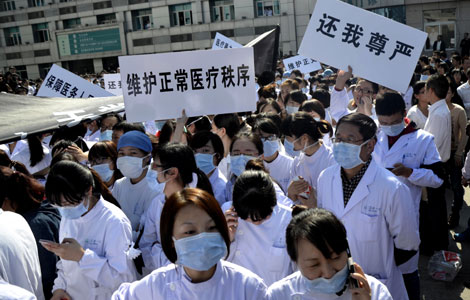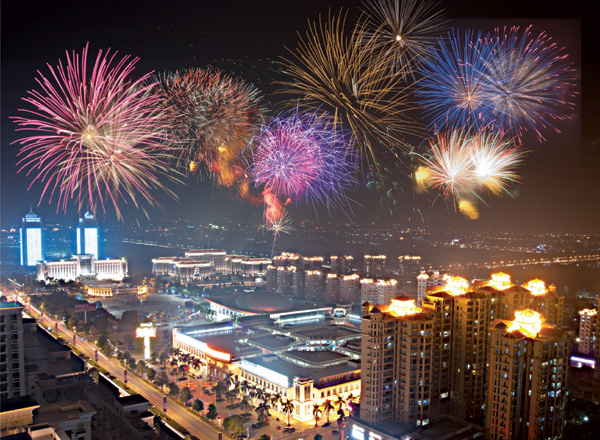Tricky switch to lighting a new world
Updated: 2013-11-04 08:10
By Qiu Quanlin in Zhongshan, Guangdong (China Daily)
|
|||||||||||
|
Guzhen is a veritable township of light, home to more than 4,000 companies engaged in making and selling lighting products. Qiu Quanlin / China Daily |
Bright future ahead for Zhongshan, the brightest spot on nation's industrial map
The hand of fate is resting nervously on the dimmer switch of China's lighting industry, not sure which way it is going to turn. For some businesses, it will get brighter; for others, dark times may lie ahead.
As the shining center of the industry, Zhongshan in Guangdong province is where the changes will be reflected the most. In the city's Guzhen township, which has a population of 80,000, more than 4,000 companies are engaged in making and selling lighting products.
According to the local government, last year the output of "China's lighting capital" was 15.81 billion yuan ($2.6 billion), accounting for more than 60 percent of the country's lighting industry total.
Lighting products worth $480 million were shipped from Guzhen to more than 130 countries and regions in 2012. Exports have increased by 42 percent year-on-year to $213 million in the first half of this year, the local inspection and quarantine authority says.
But that is only half the story. All is not as bright as it seems. In the past few years, many of Guzhen's lighting manufacturers and their 2,000 shops in the township have been switching over to LED products. In China and around the world, the much more energy-efficient and longer lasting light-emitting diode products are replacing traditional incandescent lighting, still the core of Guzhen's industry.
As part of a massive program to save energy and cut down on carbon emissions, and a continuing urbanization drive, by the end of 2015, China wants 30 percent of domestic lighting to be LED, three times more than at present, and the Ministry of Science and Technology is on record as saying it plans to create a 500 billion yuan LED industry in that time.
In doing so, tax breaks, subsidies and land deals have been offered and a reported 4,000 companies in China are now producing LED lights.
The problem is it is all happening very quickly and it is hard to see ahead clearly as that dimmer switch of fate wildly oscillates. Exciting, perhaps, but there will be casualties. Reuters reported earlier this year that 20 per cent of Chinese LED companies could be forced out of business.
The LED switchover in China is in a rush to catch up with and match advances made in Western countries in replacing traditional lighting and in technology.
The annual Guzhen International Lighting Fair only introduced a special exhibition area for LED lighting products in 2011. That year there was a huge rise in exports of Chinese LED products to Japan, following the Fukushima nuclear disaster. Since then, export volume has been declining.
Guzhen's annual fair now focuses largely on LED applications. During this year's exhibition, which ended on Oct 21, more than 200 LED lighting companies, accounting for almost half of the exhibitors, showed off their latest products.
Lin Yuanchun, an engineering manager of Zhongshan Baolong Lighting Co, says vast demand in the LED market has caused many local traditional lighting manufacturers to shift their business focus.
With about 100 new lighting companies being set up each year in Guzhen, head of the township government, Wei Hongrui, says: "After more than two decades of development, we need to develop a lighting industry with low resources, low energy consumption but high economic value to sustain industrial growth.
"More local lighting companies have entered the LED market since we encouraged an industrial upgrading some years ago."
Wei says holding the annual lighting fair is a crucial part of the township's plans to become a global lighting hub, strongly competitive in marketing, technology and innovation against, or with, the likes of major foreign LED lighting manufacturers, such as Philips, General Electric and Osram.
"We expect the hub to take shape by the end of 2015," Wei says, adding that by then Guzhen aims to realize an annual business turnover of more than 40 billion yuan and hopefully have a couple of big national or international brands operating there, each capable of annual sales volumes above 5 billion yuan.
Wei attributes the glowing rise in the LED lighting industry in part to the Guangdong government's policy of promoting energy-saving lighting products in all uses across the province. By the end of the year, about 2 million traditional road lamps in the province should be replaced by LED ones.
Outdoor and commercial lighting is driving the LED industry for the time being, but Pan Wenbo, president of Guangzhou Guangya Exhibition & Trade Co, warns of gloomier scenarios.
Today's Top News
Chinese Premier Li seeks point of balance
Reform roadmap before key meeting
Intel leaks proved justified: Snowden
Cooperation needed in terror fight
Beijing to further boost visa-free stay
Shenzhou X crew awarded for outstanding service
US to file murder complaint against LAX shooter
China's non-manufacturing PMI rises in October
Hot Topics
Lunar probe , China growth forecasts, Emission rules get tougher, China seen through 'colored lens', International board,
Editor's Picks

|

|

|

|

|

|







